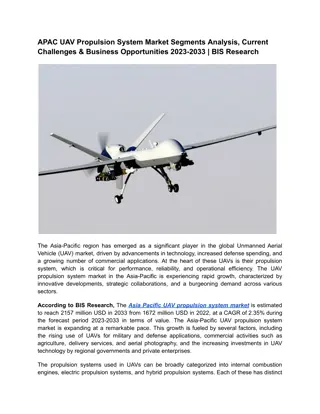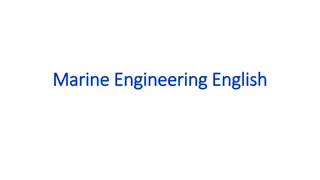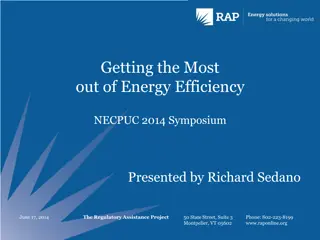NASA Cryogenic Fluid Management Flight Demonstration Summary
NASA selected 14 companies, including small businesses, to develop technologies for sustainable operations on the Moon under the Artemis program. The Cryogenic Fluid Management Portfolio Project aims to close technology gaps essential for future space missions. This Technology Demonstration Mission
0 views • 10 slides
E-bikes Market to be Worth $88.3 Billion by 2030—Exclusive Report by Meticulous Research®”
E-bikes Market by Propulsion Type (Throttle-assisted and Dual Mode), Class, Power Output, E-bike Type, Battery Type, Motor Type (Hub Motors and Mid-drive Motors), Structure, Charging Type, Charging Mode, and End User - Global Forecast to 2030\n
0 views • 6 slides
Advancing Space Exploration Through Nuclear Thermal Propulsion Engine Technology
The article discusses the development, testing, and challenges of Nuclear Thermal Propulsion (NTP) engines for space exploration. It covers the history, components, and benefits of NTP engines, as well as the specific engineering considerations and advancements in this field. The content emphasizes
6 views • 20 slides
Understanding the Digestive System Processes
The digestive system is responsible for the breakdown, absorption, and elimination of food. It involves processes such as ingestion, propulsion, mechanical and chemical digestion, absorption, and defecation. Starting from the mouth with salivary glands and oral cavity, it progresses through the esop
3 views • 38 slides
Electric Tractors Market
Electric Tractors Market by Type (Utility Tractors and Compact Tractors), Propulsion Type (BEV and HEV), Battery Capacity (Less than 15 kW and 15kW to 40 kW), Power Output, Application (Agriculture, Construction), and Geography - Global Forecast to 2031\n
1 views • 5 slides
Understanding Normal Conditions of Use for New Propulsion Technologies in Vehicles
Explore the concept of normal conditions of use for vehicles with new propulsion/charging technologies. Learn how to assess and define normal conditions, operating modes, worst case scenarios, and overview of current technologies. Discover the approach to measure normal conditions and testing requir
1 views • 8 slides
APAC UAV Propulsion System Market Segments Analysis 2023-2033
The Asia Pacific UAV propulsion system market is estimated to reach 2157 million USD in 2033 from 1672 million USD in 2022, at a CAGR of 2.35% during the forecast period 2023-2033 in terms of value.\nRead Report Overview: \/\/bisresearch.com\/industry-report\/asia-pacific-uav-propulsion-system-marke
1 views • 3 slides
Construction Equipment Market Expected to Exceed $236.9 Billion by 2031
Meticulous Research\u00ae\u2014a leading global market research company, published a research report titled, \u2018Construction Equipment Market by Type (Material Handling, Earth Moving, Concrete and Road Construction, Others), Propulsion Type (ICE, Electric, Others), End User (Construction, Governm
1 views • 4 slides
Electric Car Market Size & Forecast
Electric Car Market Size, Share, Forecast, & Trends Analysis by Propulsion Type (BEV, FCEV, PHEV, HEV), Power Output (Less than 100 kW, 100 kW to 250 kW, and More than 250 kW), and End Use (Private Use and Commercial Use) - Global Forecast to 2031\n
0 views • 6 slides
North America Electric Car Market is Expected to Reach $419.39 Billion by 2031
North America Electric Car Market Size, Share, Forecast, & Trends Analysis by Propulsion Type (BEV, PHEV, HEV), Power Output (Less than 100kW, 100 kW to 250 kW, More than 250 kW), End Use (Private, Commercial) - Forecast to 2031\n
0 views • 5 slides
Electric powertrain
The Electric Powertrain Market investigates the global shift towards electric propulsion systems in vehicles. It analyzes trends in electric motors, batteries, and power electronics driving the transition from internal combustion engines to electric powertrains.
0 views • 7 slides
Electric Powertrain Market: Projections and Growth Drivers
Electric Powertrain Market Size, Share, Forecast, & Trends Analysis by Propulsion Type (BEV, HEV, FCEV), Component (Motor\/Generator, Battery Packs, Converters, On-board Chargers, Others), Vehicle Type (Passenger Vehicles, Commercial Vehicles, Others
0 views • 5 slides
Review of Critical Heat Flux in Liquid Hydrogen, Methane, and Oxygen
This review paper presents data and predictive tools on the critical heat flux (CHF) of liquid hydrogen, methane, and oxygen. It covers the motivation for CHF modeling, background on pool and flow boiling curves, availability of CHF data for different liquids, and applications in space propulsion sy
0 views • 15 slides
Understanding Ship Propulsion Power Estimation
In the process of ship design, it is crucial to estimate the power required for propulsion to determine machinery masses, fuel consumption, and tank capacities. Power estimates can be derived through comparisons with existing vessels or model tests, involving scaling laws for different components. S
0 views • 19 slides
Understanding Algorithm Efficiency Analysis
In this chapter, Dr. Maram Bani Younes delves into the analysis of algorithm efficiency, focusing on aspects such as order of growth, best case scenarios, and empirical analysis of time efficiency. The dimensions of generality, simplicity, time efficiency, and space efficiency are explored, with a d
1 views • 28 slides
Transitioning Towards Energy Efficiency: Co-Benefit Agenda of the Kigali Amendment
The Kigali Amendment proposes a framework to incentivize energy efficiency while phasing out high-GWP HFCs. Reports highlight the urgency to limit global warming to 1.5°C, emphasizing the need for deep emission reductions across all sectors. Investments in low-carbon technologies and energy efficie
0 views • 17 slides
Thermal Efficiency and Controls in Spray Dryers
Understanding the thermal efficiency and control factors in spray dryers is essential for optimizing drying operations in various industries. Factors such as inlet air temperature, heat exchanger efficiency, and solids content influence the overall efficiency of the drying process. Higher efficiency
0 views • 9 slides
Understanding Energy Efficiency in Devices
Energy efficiency is a crucial concept in understanding how well devices convert energy from one form to another. This summary covers the basics of energy stores, calculation of efficiency, and ways to improve efficiency in devices. Explore the different types of energy stores such as batteries, str
0 views • 15 slides
Understanding Workpapers in Energy Efficiency Programs
Dive into the world of workpapers in energy efficiency programs, covering topics such as workpaper development, deemed energy efficiency measures, the Database of Energy Efficiency Resources (DEER), and the components that make up a workpaper. Explore why workpapers are essential for providing neces
0 views • 119 slides
Understanding Maglev Technology: Levitation, Propulsion, and More
Maglev technology, short for magnetic levitation, utilizes magnetic power to levitate and propel vehicles such as trains. This seminar explores the basic principles, types, and components of Maglev trains, focusing on Electromagnetic Suspension (EMS) and its levitation, propulsion, and lateral guida
0 views • 14 slides
The Trouble with Rockets: Fuel Efficiency and Space Travel Challenges
Rockets face challenges due to the need to carry their own fuel, with various propulsion methods offering different levels of efficiency. From chemical rockets to advanced technologies like Ion Engines and Laser Ablation Plasma, the quest for efficient space travel continues. By considering specific
0 views • 11 slides
Efficiency Analysis of Microfinance Institutions in Papua: A Study by Dr. Muneer Babu
Analysis of the performance and efficiency of Microfinance Institutions in Papua New Guinea, focusing on the provision of financial services to the underbanked population. The study evaluates the resource utilization and efficiency of MFIs, comparing less efficient and highly efficient institutions.
0 views • 18 slides
Global Space Propulsion System Market
The Global Space Propulsion System Market size is anticipated to exceed USD 38.74 Billion by 2032, growing at a CAGR of 14.5% from 2022 to 2032.
5 views • 7 slides
Understanding Energy Efficiency in Boiler Systems
Learn about the importance of energy efficiency in boiler systems, the different types of boilers, boiler components, major losses in boiler efficiency, methods for assessing efficiency, and calculations using the direct method. Exploring topics such as boiler efficiency, water treatment systems, fu
2 views • 55 slides
Marine Engineering: Functions and Types of Engines
Marine engineering plants are essential for converting fuel energy into useful work to power various ship systems, including propulsion. The primary function of these plants is to utilize chemical energy for steering, lighting, ventilation, air conditioning, heating, refrigeration, and propulsion. T
1 views • 45 slides
Understanding the Phases of Gait Cycle
Gait is a rhythmic motion of the lower extremities characterized by alternating propulsive and retropulsive movements. The Gait Cycle consists of Swing Phase and Stance Phase, each crucial for walking efficiency. Stance Phase is further divided into stages like Initial Contact, Loading Response, Mid
0 views • 20 slides
Understanding Energy Efficiency and Conservation Fundamentals
This unit introduces basic terms related to energy, efficiency, and conservation, covering topics such as Efficiency and Conservation Energy, First and Second Law of Thermodynamics, and various heat transfer mechanisms. It emphasizes responsible energy use, focusing on efficiency, conservation, and
0 views • 14 slides
Understanding EU Legislation and Energy Efficiency in Buildings
This module explores the EU legislation and energy efficiency in buildings with a focus on Nearly Zero Energy Building (nZEB) concepts. It covers the importance of increasing energy efficiency in buildings in the EU, showcasing statistics on energy consumption and CO2 emissions. By improving energy
1 views • 23 slides
Enhancing Energy Efficiency for Sustainable Development
This content covers a symposium on maximizing energy efficiency, presented by Richard Sedano at the NECPUC 2014 event. It introduces the Regulatory Assistance Project (RAP), a non-profit organization aiding government officials in energy and environmental issues with a focus on cost-effective energy
1 views • 27 slides
Addressing Energy Efficiency in Cooling Sector: 2021 Report Highlights
The 2021 update report from the TEAP Energy Efficiency Task Force emphasizes the critical nature of the climate emergency and the need to transition to lower GWP refrigerants and higher efficiency cooling systems. The report focuses on initiatives to enhance the efficiency of room ACs and refrigerat
0 views • 44 slides
Mercury Exploration Technology Goals and Challenges
The exploration of Mercury presents unique challenges due to extreme conditions such as high solar irradiance, wide temperature variations, and long periods of sunlight and darkness. The Mercury Exploration Technology Goals document outlines areas of interest including launch systems, propulsion, th
0 views • 13 slides
Understanding Power Consumption and Resistance in Marine Engineering
Learn about hull resistance, factors affecting resistances and power consumption, propulsion chain efficiency, and power consumption of auxiliary equipment and hotel load in marine engineering. Explore different types of resistance such as frictional, residual, eddy, wave, and air resistance, along
0 views • 15 slides
Enhancing Energy Efficiency in Saudi Arabia: SEEC's Impactful Initiatives
The Saudi Energy Efficiency Center (SEEC) plays a crucial role in improving energy efficiency in Saudi Arabia through strategic programs and initiatives. Established in 2010, SEEC focuses on sectors like transportation, industry, and buildings, with a goal to reduce energy consumption and promote aw
0 views • 29 slides
Australia's Clean Energy Future: Role of Energy Efficiency Programs
The discussion revolves around Australia's clean energy future and the pivotal role of energy efficiency in driving sustainable practices. It covers topics such as the Carbon Pricing Mechanism, Encouraging Energy Efficiency initiatives, and the Equipment Energy Efficiency Program (E3). The success s
0 views • 13 slides
Nuclear Propulsion Systems Transportation Overview
This document provides detailed information on the transportation of nuclear propulsion systems, including components from fabricators to testing facilities and assembly transport considerations. It covers various shipment types, container requirements, and post-irradiation transport scenarios. The
0 views • 6 slides
Overview of Korea's Energy Efficiency Programs and Compliance Issues
Korea's energy efficiency programs include mandatory labeling and standards for various products such as refrigerators, air-conditioners, and TVs. The country faces compliance challenges related to adopting the standards of Energy Frontier, which focus on ultra-high efficiency products. Strategies t
0 views • 19 slides
Preliminary Wing Sizing and Design Process Overview
Explore the preliminary design process for wing sizing in aircraft engineering, including key topics, weight estimation spreadsheets, configuration layouts, propulsion system options, and structural considerations. Dive into sensitivity studies, takeoff thrust, aspect ratios, payloads, and more to r
0 views • 9 slides
Exploring the Ethics of Efficiency in Economics Education
Delve into the intriguing discussion on whether efficiency is ethical in the realms of economics and education. This session, featuring the new Ethics, Economics, and Social Issues curriculum through EconEdLink, analyzes the concept of efficiency through diverse examples and engages participants in
0 views • 26 slides
Increase in Precipitation Efficiency with Surface Warming
The study examines how surface warming affects precipitation efficiency in radiative-convective equilibrium. Various factors influencing precipitation efficiency, such as microphysical processes and climate sensitivity, are discussed. Model experiments are conducted to test the sensitivity of precip
0 views • 33 slides
UAV Propulsion System Market
The global UAV propulsion system market is estimated to reach $10.76 billion in 2033 from $8.36 billion in 2022, at a CAGR of 2.33% during the forecast period 2023-2033.\n\nRead Report Overview: \/\/bisresearch.com\/industry-report\/uav-propulsion-sy
1 views • 3 slides







































